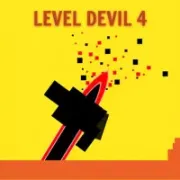
Simulation

Drift Boss Arena
More games to drift through
Swap tabs in seconds and keep the momentum going with another arcade favorite.

Simulation

Puzzle

Racing

Comedy

Sports

Simulation

Clicker

Platformer

Simulation

Simulation

Action

Simulation

Adventure

Racing

Simulation
Puzzle
Master hidden traps across 40 bite-size stages. Sharpen reflexes, read the terrain, and sprint to the yellow exit in Level Devil Trap Path—no fluff, all skill.
Level Devil Trap Path invites you into a minimalist platform challenge where caution is as valuable as quickness. Across forty handcrafted stages, the ground buckles, ceilings bite, and walls conceal mechanisms that react the instant you stray too near. With a spare pixel-art look and crisp movement, the focus stays entirely on reading the level and making decisive moves. Because surprises are the rule, not the exception, Level Devil Trap Path rewards players who learn the map, anticipate danger, and commit with confidence.
Each stage in Level Devil Trap Path teaches you to scan before you sprint. Triggers hide in safe-looking tiles, spikes slide from off-screen slots, and platforms collapse only after a half-beat delay. The cadence becomes familiar: pause, probe, then pounce. After a few attempts you will sense where designers want your eyes to go—and where they hope you won’t look. This dynamic makes even a tiny room feel like a puzzle box, and it is why Level Devil Trap Path feels addictive without relying on timers or power-ups.
Your toolkit in Level Devil Trap Path is intentionally small but exact. Tap A to step left, feather D to line up on tight footholds, and hit W for a hop that is tuned for one-tile gaps and spike lips. Momentum is light, so micro-adjustments are reliable. That precision matters because a single extra pixel can spring a pressure plate. Mastering the feel of these three keys is what turns Level Devil Trap Path from trial-and-error into a flow state.
The signature of Level Devil Trap Path is misdirection without malice. You will encounter tiles that appear ordinary until your toe grazes them; once tripped, they unleash blades, retract platforms, or flip gravity wells. The tells exist—hairline cracks, odd spacing, a change in tile rhythm—but they ask you to slow down and look. That is the contract this game offers: it will hide dangers cleverly, but it will also seed the clues to read them. Learn that language, and Level Devil Trap Path becomes less about luck and more about literacy.
Across the early chapters, Level Devil Trap Path introduces one idea at a time: collapsing floors, springboards that over-shoot the safe ledge, doors that only unlock if you bait a hazard. Later rooms combine these verbs. You might need to trigger a falling platform, ride its drop, then bail at the last frame to avoid a dart. Because resets are instant, the loop stays brisk, and you can convert each failure into information. With repetition, you build a personal glossary of patterns unique to Level Devil Trap Path—a mental shorthand for where not to plant your foot and when to dash.
Observation is the strongest skill you can bring into Level Devil Trap Path. Before your first step, scan for asymmetries. Are two blocks spaced evenly while a third sits one pixel off? Did the level architect place a single coin where they want you to stand? Little cues like these are often maps to invisible machinery. The more you practice this pre-movement ritual, the less you will be surprised, and the more you will feel in command of Level Devil Trap Path rather than reacting to it.
Use a deliberate walk to inch toward suspicious edges, then mark safe footholds in your mind. Feather the jump so you land on the topmost pixel of a platform; it can keep you outside a trigger radius. When a trap fires, fight the impulse to retreat immediately—sometimes the smart play in Level Devil Trap Path is to advance into the gap it created. Tools are simple, but they combine elegantly once you trust the physics.
Rooms in Level Devil Trap Path are compact, which means success is never far away. A clean execution might last only a few seconds, yet those seconds demand complete focus. That micro-burst intensity is the game’s hook. Even after a tough failure, the restart is instant, so you are back within the puzzle in a blink. Over time you will notice that your first-try clears increase because Level Devil Trap Path trains a habit of checking corners and counting beats before you leap.
Impatience is the most dangerous enemy in Level Devil Trap Path. Sprinting blindly usually stacks triggers in the worst possible order. Instead, test a step, retreat, and try a different angle. You are not penalized for caution; the fastest line often starts with the slowest look. Many of the seemingly unfair moments soften once you realize how deliberately the level telegraphs its trick. The joy comes from decoding, not just dodging, and that is where Level Devil Trap Path distinguishes itself from louder platformers.
First, warm up with a few micro-hops to sync your hands to the jump arc of Level Devil Trap Path. Next, make a habit of probing edges with partial steps; learn the distance that does not yet tickle a pressure plate. Third, rehearse contingency plans: if a floor gives way, decide whether you hold jump to catch the lip or ride the drop and leap late. Establishing these micro-routines reduces panic and makes the most devious rooms in Level Devil Trap Path feel manageable.
Think of every mistake in Level Devil Trap Path as a note. Where did the spike emerge from? Which tile changed color right before it moved? Did the platform delay on a half-beat or a full beat? Logging tiny details, even subconsciously, turns the next attempt into a measured plan. The distance between confusion and mastery is often just three restarts, because each death stamps a new coordinate onto your internal map of Level Devil Trap Path.
Once you understand a room, the race to the exit becomes poetic. You string together micro-pauses, perfect hops, and baited triggers like notes in a melody. In these moments, Level Devil Trap Path transforms again—from a cautious puzzle to a confident sprint. The yellow door becomes less a finish line and more a cadence marker for your route. Chasing cleaner lines and earlier baits is what turns late-game rooms into playgrounds. Once you know when each spike fires, you can improvise flourishes—extra coin grabs, stylish feints, or reckless speed bursts—without losing composure.
If you crave platformers that reward caution first and swagger second, Level Devil Trap Path is a perfect side chapter. Trust the tells, log every fakeout, and enjoy the moment when the maze finally feels like yours.
Need more drift intel? Read the Drift Boss Help Center or contact our crew through the support page.